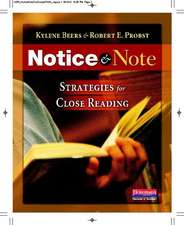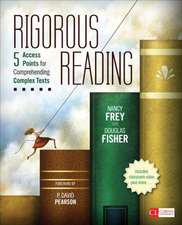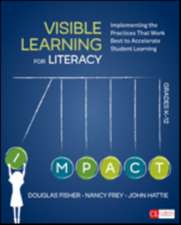50 Instructional Routines to Develop Content Literacy: Teaching Strategies
Autor Douglas Fisher, William G. Brozo, Nancy Freyen Limba Engleză Paperback – 20 feb 2014
Some of the best-known authors in the field come together to provide teachers with fifty step-by-step procedures for implementing content area instructional routines to improve studentsGÇÖ literacy skills. 50 Instructional Routines to Develop Content Literacy, 3/e helps adolescents to become more successful readers. Middle and high school teachers can immediately put to use its practical information and classroom examples from science, social studies, English, math, the visual and performing arts, and core electives to improve studentsGÇÖ reading, writing, and oral language development. Going above and beyond basic classroom strategies, the instructional routines recommend simple changes to teachersGÇÖ everyday instruction that foster student comprehension, such as thinking aloud, using question-answer relationships, and teaching with word walls.
The routines are:
- Selected to ensure that all students engage in reading, writing, speaking, listening, and viewing as part of the literacy process.
- Taken from real classrooms, real students, and real results.
- Organized for easy and quick referencing.
- Applicable to English learners and struggling readers.
Preț: 367.78 lei
Nou
70.37€ • 73.48$ • 58.24£
Carte disponibilă
Livrare economică 14-28 martie
Specificații
ISBN-10: 0133347966
Pagini: 148
Dimensiuni: 217 x 276 x 6 mm
Greutate: 0.3 kg
Ediția:3
Editura: Pearson
Seria Teaching Strategies
Notă biografică
Textul de pe ultima copertă
- Selected to ensure that all students engage in reading, writing, speaking, listening, and viewing as part of the literacy process.
- Taken from real classrooms, real students, and real results.
- Organized for easy and quick referencing.
- Applicable to English learners and struggling readers.
- NEW!More detailed classroom scenarios.
- NEW! New routines that address the Common Core State Standards.
- NEW! Up-to-date research reviews and references.
- NEW! A focus on additional content areas.
Cuprins
Table of Contents
1) Adjunct Displays
2) Annotation
3) Anticipation Guides
4) Close Reading
5) Collaborative Conversations
6) Conversation Roundtable
7) Debate
8) Directed Reading-Thinking Activity
9) Exit Slips
10) Fishbowl Discussions
11) Found Poems
12) Generative Reading
13) Guest Speakers
14) Independent Reading
15) Interest Surveys, Questionnaires, and Interviews
16) Jigsaw
17) KWL
18) Language Experience Approach
19) Mnemonics
20) Modeling Comprehension
21) Numbered Heads Together
22) Opinionnaire
23) Popcorn Review
24) Questioning the Author
25) Question-Answer Relationship
26) RAFT Writing
27) Read-Alouds
28) Readers' Theatre
29) Read-Write-Pair-Share
30) Reciprocal Teaching
31) ReQuest
32) Response Writing
33) Shades of Meaning
34) Shared Reading
35) Socratic Seminar
36) Split-Page Notetaking
37) Student Booktalks
38) Student Questions for Purposeful Learning
39) Text Impressions
40) Text Structures
41) Text-Dependent Questions
42) Think-Alouds
43) Tossed Terms
44) Vocabulary Cards
45) Vocabulary Self-Awareness
46) Word Grids/Semantic Feature Analysis
47) Word Scavenger Hunts
48) Word Sorts
49) Word Walls
50) Writing Frames and Templates









